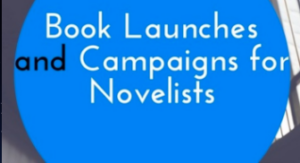The What, Why, How of Book Launches and Campaigns
 Your book is ready to be published or will be soon — in the next three or six or twelve months. Actually you can’t start too early thinking about and planning your book launch.
Your book is ready to be published or will be soon — in the next three or six or twelve months. Actually you can’t start too early thinking about and planning your book launch.
The day you release your book to world is special — celebrate!
Let’s get down to the brass tacks and give you some context. Warning: This article will get woo-woo and practical at the same time. Strap on your curiosity tool belt and adventuring hat.
What is a book launch and what are campaigns?
We’re not talking a military campaign — though that’s probably where the word comes from — but it does require advance planning, like a military campaign. You’re not conquering anyone or anything. Instead in a campaign you’re purposefully spreading the word about your book for a specific purpose in a specific time frame.
Your book campaign could take one of these forms:
- Book review requests
- Requesting early reader reviews
- Cover reveal blast
- Pre-order campaign
- Book blast
- Giveaways
- On Sale Announcement
- Special offers
- Limited time offers on sneak peeks
- A book launch event(s)
- An event, like a book signing or appearance
Why do a book campaign?
We novelists are often scattered. Marketing can feel like herding cats, or like operating a multi-headed hydra. Take your pick of metaphor. Or make your own.
So, running a campaign will help you feel organized, have a measurable markers for success tracking, and give you a start and end date. All things useful when you’re used to writing novels that take a long time.
HOW TO SET UP YOUR CAMPAIGN: FOUNDATION WORK
The brainstorming exercise can take anywhere from 15 minutes to an hour or more.
GOALS
Firstly, and most importantly, think about your end goal. What do want?
Let’s break it down using the GMC, and S. Thank you to Deb Dixon and her book, GMC: Goal, Motivation, & Conflict for the structure of GMC. S is for Strengths and something I added, starting in my self-coaching guide for writers, The Writer’s Adventure Guide.
OUTER GOAL
Do you want sales? Increase your mailing list size, meet new people, sign books, give away a certain number of books, generate a certain number of reviews? Get your name and book in front of a certain number of people? What else?
List your outer goals.
Then prioritize, numbering them from most important to least. Circle the top three. Can you accomplish them in one activity? If not, narrow your priority down to number one and choose that book marketing campaign. Make sure it will help you get to this goal. If it does, pick something else. If you’re not sure, make your best guess. Successful authors experiment to discover what works.
INNER GOAL
Get clear on your internal goal. Another way to frame this is what do you want to experience as a result of this campaign? Or any campaign you choose. Set aside the specifics of a campaign, and focus now on the emotional experience you want to have.
Some examples could be: accomplished, proud, calm, excited like bubbly champagne, thrilled, grateful, awed, warmed like a cat in the sun. Be descriptive, metaphoric, and specific.
Jot down the experience you’d like.
MOTIVATION
Now that you are clear on what goals you want, get specific about why you want these.
The important thing to ask here is: Why do I want these?
Then once you have the answer, don’t stop there. Go deeper.
Ask yourself: What will having that do for you? (Speak to yourself from an interviewer position. That helps get clarity.) (Note: This odd wording comes from my training in NLP, neuro-linguistic programming.)
Ask this a few times, at least three times, until you come to what feels like the heart of the matter.
It’s important to be as clear as possible on what drives you, so that you have a touchstone to return to and motivate you when the going gets rough.
Example: I want to do a special pre-order campaign — pre-order book 3 and get book 1 and 2 for free — and I want to feel excited like I’m soaring like an eagle. Because I want to spread the word about my book.
What will having that do for you? Then I’ll feel blessed that more people will be touched by the powerful messages in this book.
And what will having that do for you? Then I’ll feel like I’m doing my life’s work at bringing this message of female empowerment out into the world.
And what will having that do for you? Then I’ll be on purpose, on message, on point.
From this exercise, I glean how deeply rooted my marketing efforts is connected to my big WHY — bigger than just publishing this one book.
Come back to your present state after that deep dive into your truest desires. We have a campaign to plan!
CONFLICTS
Because all good stories have conflicts, and knowing what your challenges are will help you face them head on.
OUTER CONFLICTS
Get clear on what’s not working, what resources you may not have that you think you need, and anything in the way of doing the campaign you’ve chosen.
These can include: a small or nonexistent budget; no support team, or not enough time in the schedule.
INNER CONFLICTS
These can include the feeling of not having enough time, being tired, confused, overwhelmed, frustrated, not clear on all the steps to execute the campaign. Include here inner experiences and beliefs and skills needed.
At this stage of examining conflicts, just notice and be gentle with yourself, receiving the information as if you’re a curious and loving being.
Now that you’ve examined the GMC of your book marketing, and you have some idea of what campaign you’d like to run, let’s look at Strengths.
STRENGTHS
Strengths are the tools, both inner and outer, that you currently have.
OUTER STRENGTHS
These could be your support friends, colleagues, significant others, fans, readers, a place to work, the technology tools helping you — your computer, smart devices, etc.
INNER STRENGTHS
These include your experience and know how, wisdom from the school of hard knocks, persistence, creativity, humor, ingenuity, etc.
I find it’s extremely helpful to do this GMC and S inventory at the start of every project, so that you know what you want, why you want it, what’s in the way, and what strengths you already have.
Jot down your inner and outer strengths.
SET UP A TIMELINE
Get out your calendar and pick a start date and an end date for your campaign. A sports and entrepreneur coach I studied with recommends two week campaigns, as a starting place. I too recommend two weeks in many cases, where it makes sense, and often use this timeframe in pre-order promotions and giveaways. It’s a nice compressed segment of time, but you can choose any time frame that works for your circumstances.
LIST YOUR INGREDIENTS
Like putting a recipe together, list all the things you’ll need to bring your campaign to life. Each campaign will be unique, but probably has these ingredients:
— CALL TO ACTION (CTA): What action are you asking your reader/fan to take? Focus on one. You’ll need to draft these of varying lengths so that they can be shared on various media, like tweets, posts, blog posts, and emails.
— IMAGES: You’ll need your book cover, and perhaps “creatives” or “memes” — images with words, in other words: ads. I love using Canva.com for these. It’s a free online service, a type of Photoshop for dummies. (It does have an upgraded paying version, too, if you want even more features, but I find the free version just fine for my needs.)
— ABOUT THE BOOK: I find it’s helpful to craft very short descriptions of the book, if you haven’t already. Craft a 1-sentence, 2-sentence, and 4-sentence blurb about your book.
— ALLIES: FORMAL AND INFORMAL — Who can help you spread the word? Do you belong to a writing community in your sub-genre that can help spread the word to their lists and groups? Do you have a street team or informal group of readers who can share for you? Do you have other writers/editors who can look at your messaging before you send it out into the world? All of these are important. Making a list of people you can ask is a very important step in preparing your campaign. Included in the category is bloggers, reviewers, media — that you may ask to spread the word for you as a formal part of your campaign.
ACTION STEPS
These steps are generalized, but can work with just about any campaign. These steps pre-suppose you have a blog, social network contacts, and a newsletter.
1. Post your call to action as a blog post, with all the information, images, links.
If your blog auto populates to your social networks, (using a service like Networked Blogs), then you don’t necessarily need to do the next step.
2. Post to your social networks, tailoring the language to fit each.
3. Ask your allies to spread the word for you, as appropriate.
4. Daily: Spread the word about your campaign in one new way. Here are some of those ways:
— Email some friends;
— Put out a newsletter;
— Mention it in social in an offhanded way, inside of a “what’s up with me” post or “here’s a cute kitten” post, etc., aligned with your brand of course;
— Tell one or two people in the real world;
— Ask one person who you think can help you but you’re not sure, so take the risk.
5. At the halfway mark of your campaign, send out a big reminder via your blog post and social messaging.
6. Three days before the end of your campaign, send out another batch of reminders: “Only 3 days left.”
7. The day before and the last day of the campaign send out further short reminders.
8. A few days after the campaign is over, share in a way that’s appropriate, what you learned, gained, what your results were. This is important both as a thank you to your fans and supporters, but also to seal in the learning and what that experience was like for you. Did you meet your goals, both inner and outer? What did you learn? What would you like to change for next time? What really worked?
Good luck and let me know how things go!
c. 2016 – 2023 Beth Barany






